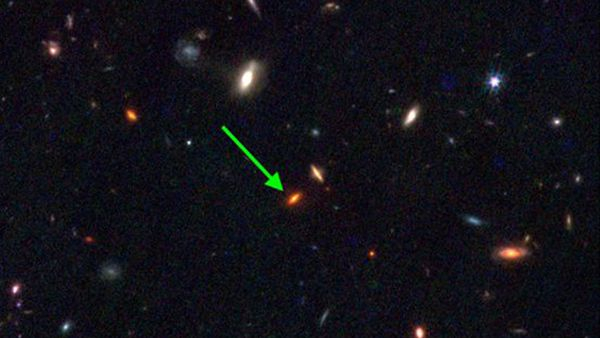James Webb telescope finds ancient galaxy larger than our Milky Way, and it's threatening to upend cosmology
Astronomers believe the first galaxies formed around giant halos of dark matter. But a newly discovered galaxy dating to roughly 13 billion years ago mysteriously appeared long before that process should have occurred.

The James Webb Space Telescope (JWST) has found a galaxy in the early universe that's so massive, it shouldn't exist, posing a "significant challenge" to the standard model of cosmology, according to the study authors.
The galaxy, called ZF-UDS-7329, contains more stars than the Milky Way, despite having formed only 800 million years into the universe's 13.8 billion-year life span. This means they were somehow born without dark matter seeding their formation, contrary to what the standard model of galaxy formation suggests.
How this could have happened is unclear, but much like previous JWST discoveries of other inexplicably massive galaxies in the early universe, it threatens to upend our understanding of how the first matter in the universe formed, or possibly even the standard model of cosmology itself. The researchers published their findings Feb. 14 in the journal Nature.
Related: Right before exploding, this star puffed out a sun's worth of mass
"Having these extremely massive galaxies so early in the universe is posing significant challenges to our standard model of cosmology," study co-author Claudia Lagos, an associate professor of astronomy at the International Centre for Radio Astronomy Research, said in a statement. This is because massive dark matter structures, which are thought to be necessary components for holding early galaxies together, did not yet have time to form this early in the universe, Lagos added.
Light travels at a fixed speed through the vacuum of space, so the deeper we look into the universe, the more remote light we intercept and the further back in time we see. This is what enabled the researchers to use JWST to spot ZF-UDS-7329 roughly 11.5 billion years in the past.
By studying the spectra of light coming from the stars of this extremely distant galaxy, the researchers found that the stars were born 1.5 billion years prior to that observation, or roughly 13 billion years ago.
Get the Space.com Newsletter
Breaking space news, the latest updates on rocket launches, skywatching events and more!
Astronomers aren't certain when the very first globules of stars began to clump into the galaxies we see today, but cosmologists previously estimated that the process began slowly within the first few hundred million years after the Big Bang.
Current theories suggest that halos of dark matter (a mysterious and invisible substance believed to make up 25% of the present universe) combined with gas to form the first seedlings of galaxies. After 1 billion to 2 billion years of the universe's life, the early protogalaxies then reached adolescence, forming into dwarf galaxies that began devouring one another to grow into ones like our own.
But the new discovery has confounded this view: Not only did the galaxy crystallize without enough built up dark matter to seed it, but not long after a sudden burst of star formation, the galaxy abruptly became quiescent — meaning its star formation ceased.
"This pushes the boundaries of our current understanding of how galaxies form and evolve," study co-author Themiya Nanayakkara, an astronomer at the Swinburne University of Technology in Australia, said in the statement. "The key question now is how they form so fast very early in the universe, and what mysterious mechanisms lead to stopping them forming stars abruptly when the rest of the universe is doing so."
The researchers' next steps will be to search for more galaxies like this. If they find any, it could seriously contradict prior ideas of how galaxies formed, they said.
Join our Space Forums to keep talking space on the latest missions, night sky and more! And if you have a news tip, correction or comment, let us know at: community@space.com.

Ben Turner is a U.K. based staff writer at Live Science. He covers physics and astronomy, among other topics like weird animals and climate change. He graduated from University College London with a degree in particle physics before training as a journalist. When he's not writing, Ben enjoys reading literature, playing the guitar and embarrassing himself with chess.
-
Fire-Starter James Reply
Someone please apply V(r)=c*tanh(Hr/c) to be Hubble's Law, just to see what difference it makes? Also apply relativity to masses, time rates, etc. I really think it'll help. That galaxy may be super farther away than they think it is. And maybe the universe is older than they think, too.Admin said:Astronomers believe the first galaxies formed around giant halos of dark matter. But a newly discovered galaxy dating to roughly 13 billion years ago mysteriously appeared long before that process should have occurred.
James Webb telescope finds ancient galaxy larger than our Milky Way, and it's threatening to upend cosmology : Read more -
Atlan0001 Reply
Time, singularly, in each linear string is finite and the universes in all their turnovers are not older, or rather not much older if any older, than they think. The broad horizon, though, of all the offsetting time-strings (plural) is eternal.Fire-Starter James said:Someone please apply V(r)=c*tanh(Hr/c) to be Hubble's Law, just to see what difference it makes? Also apply relativity to masses, time rates, etc. I really think it'll help. That galaxy may be super farther away than they think it is. And maybe the universe is older than they think, too. -
bwana4swahili Another nail in the coffin of the ridiculous concept of dark matter! Maybe the gravy train of dark matter research is finally coming to an end and some reasonable theory will be proposed.Reply -
Setpoint As Hamlet said, "There is more to heaven and earth, Horatio, than is dreamt of in your philosophy."Reply -
ultimatewizz Reply
What puzzles me is if there are more than one galaxy and the universe is infinite then why aren't some galaxies that are not part of our big bang moving toward us as they expand in their part of the universe. How can everything we see be moving away from us when we are not the center of the galaxy/universe?Admin said:Astronomers believe the first galaxies formed around giant halos of dark matter. But a newly discovered galaxy dating to roughly 13 billion years ago mysteriously appeared long before that process should have occurred.
James Webb telescope finds ancient galaxy larger than our Milky Way, and it's threatening to upend cosmology : Read more -
rod Space.com reported, "The James Webb Space Telescope (JWST) has found a galaxy in the early universe that's so massive, it shouldn't exist, posing a "significant challenge" to the standard model of cosmology, according to the study authors. The galaxy, called ZF-UDS-7329, contains more stars than the Milky Way, despite having formed only 800 million years into the universe's 13.8 billion-year life span. This means they were somehow born without dark matter seeding their formation, contrary to what the standard model of galaxy formation suggests."Reply
FYI, this is not the first report on JWST and early galaxies with large redshifts not playing well with cosmology, LCDM model of the Big Bang.
James Webb's 'too massive' galaxies may be even more massive, https://phys.org/news/2023-05-james-webb-massive-galaxies.html
"The first results from the James Webb Space Telescope have hinted at galaxies so early and so massive that they are in tension with our understanding of the formation of structure in the universe. Various explanations have been proposed that may alleviate this tension. But now a new study from the Cosmic Dawn Center suggests an effect which has never before been studied at such early epochs, indicating that the galaxies may be even more massive." -
Classical Motion This is one heck of an "in your face" observation. We should not see this.Reply
That is a very large and old spec of dust to form so early. With present consensus.
The only conclusion is that the cosmos is much older than thought. And probably a lot larger.
Or a consensus change.

